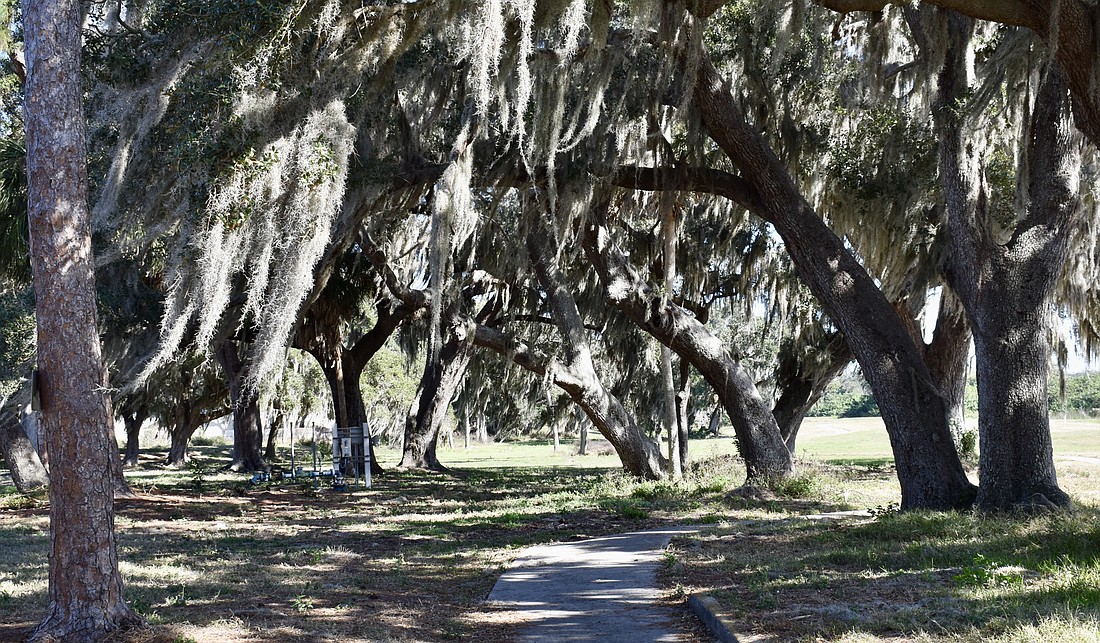- November 26, 2024
-
-
Loading

Loading

Visitors come to Florida’s Gulf Coast expecting to experience its many varieties of palm trees swaying in the gentle sea breeze. The local environment, though, relies on a lush canopy provided by “grand trees” to provide shade, shelter and natural habitats.
Last week, the Sarasota City Commission debated the merits of those competing interests as commissioners approved an amended tree ordinance intended to preserve and enhance the canopy provided by live oaks and other preferred hardwoods while eliminating palms as an option for replacing shade trees removed from single-family residential lots.
The second reading of the ordinance updates sparked a 90-minute discussion that ended in a split 3-2 approval. A second reading was required as the measure previously fell short of unanimous support. Adjustments made by staff in the interim failed to satisfy Mayor Erik Arroyo and Commissioner Hagen Brody, who cast the dissenting votes.
“The idea is to replace our canopy. That’s what we're trying to do with this,” said Commissioner Liz Alpert. “I get questions and comments all the time about 'Will this ordinance save our canopy?' And I say it's a step in the right direction. It's not perfect, but it's definitely a step in the right direction.”
The amended ordinance incorporated recommendations of the Tree Advisory Committee and city staff to decrease the size of required replacement trees, change the methodology for determining required mitigation, allow residential property owners to remove trees for landscaping, and create site evaluation and species selection criteria for replacement trees.
It also created categories of recommended trees and undesirable trees, the latter of which don’t apply credit to the tree replacement rules. It also amended the definition of grand tree and created a definition of canopy tree.
The replacement formula for removed trees is intended to include simpler and less burdensome requirements for residential property. The tree replacement formula remains unchanged from the prior code section for all property other than single-family residential.
Foremost among the changes from the draft ordinance recommended by staff was the elimination of exemptions of certain tree replacement rules for the barrier islands and the use of palm trees as mitigation for the removal of grand trees.
Staff recommended a “3-6-9 rule” that would have required three palms to be planted per tree removed of 4- to 16-inch trunk diameter, six palms per 16- to 30-inch tree removed and nine palms for trees larger than 30 inches. The palm mitigation, though, would have applied only to the barrier islands, granted an exemption to the canopy tree requirements out of concern that some trees cannot thrive in harsh coastal conditions.
Brody and Arroyo dismissed the notion of significantly different environmental conditions between the barrier islands to the mainland, their opinion backed by staff.
“One of the reasons we started to go down this road was to allow people on the barrier islands, who are the biggest proponents of it, to use utilize palm trees,” Arroyo said. “I feel, as staff does, that it should be equitable, that it should be applied citywide.”
Added Brody on the mainland prohibition, “I don’t understand the war on palm trees.”
Commissioner Jen Ahearn-Koch sought clarification of the staff’s position with regard to palms while questioning Senior Arborist Mark Miller and General Manager of Development Services Kevin McAndrew.
“Can you explain to me why staff recommends going citywide with palm tree as mitigation trees as opposed to just on the barrier islands?” she asked. “The point of equity doesn't really come into play for me. The point was there are special conditions out there with the sea and the sand and so forth. Am I misunderstanding that?”
“Staff is very much behind the idea that tree replacement be canopy trees,” Miller said. "The issue, though, with the exemption on the barrier islands, is that there are a number of professionals that work in this city, as well as in-house on staff, that believe that canopy trees can thrive and do well on the barrier islands. And that is our position. We do think there is an equity issue then, that if there is this exemption on the barrier islands should be applied citywide.”
Or not applied at all, as the palm tree mitigation option was eventually removed entirely.
Although that sentiment eventually carried the day, it wasn’t unanimous.
Brody said it was hypocritical to scratch the palm tree option in light of the city’s liberal use of palms on streetscapes and on public property.
“I don't think we should eliminate the possibility of using palm trees for mitigation,” Brody said. “We as a city choose that all the time. We want palm trees downtown. We want palm trees on our some of our main corridors. We're making a law we wouldn't even want to follow ourselves.”
Brody added his objection to the fee of $8,700 in lieu of replacing trees was, saying it was too high. Arroyo said the fee has too much of an impact on lesser affluent neighborhoods.
“If you take down a 29-inch tree, you have to plant two three-inch trees, which is like $675 a tree, so you come in at $1,350,” Arroyo said. “But if you were to donate to the tree fund, you'd have to pay $8,700, so there's a there's a great disparity.”
“It’s an attempt at incentivizing planting versus paying,” replied Assistant City Attorney Joe Mladinich.
Added Arroyo, “I believe this is more burdensome, especially on our poorer neighborhoods who maybe don't follow city commission meetings, and it doesn't provide flexibility. The fees are just out of control and it creates a different class. You never want to create different classes of residents.”